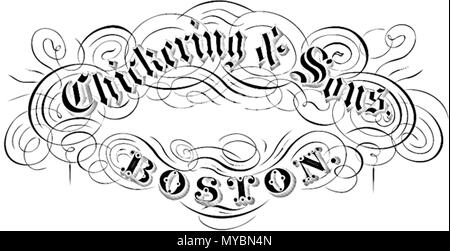Serial number locations are found: 1) On the piano’s cast iron plate, near the tuning pins, as you face the keys. Look to the right or to the left. 2) The Capo d'astro bar. Located on the right, this acts as a 'bridge' to the 'beams' of the cast iron plate. 3) On the piano's soundboard (see link above for a diagram). As part of our ongoing research, the Chickering Foundation maintains a registry of all extant or known Chickering pianos from before 1890 of which it becomes aware. To have your pre-1890 Chickering (serial numbers below 100,000) included in the Registry, send an email to info@chickeringfoundation.org. About the Chickering Foundation. Chickering and Sons Baby Grand piano ChickeringChickering and Sons Baby Grand piano Chickering and Sons Baby Grand piano, circa 1978, serial number 242788, having a Neoclassical laquered case having; Antique Steinway & Sons Mahogany Grand Piano:Antique Steinway & Sons Mahogany Grand Piano: Antique Steinway & Sons New York Model L Grand Piano.
PIANO APPRAISALS
Discover Your Pianos Current Market Value So You Can Sell It For The Best Possible Price
MANUFACTURING DATES
Stop Guessing!… Find Out Exactly How Old Your Piano Is With Our Piano Age Calculator
LARGEST PIANO DATABASE
Instantly Accesses The Most Current & Comprehensive Piano Research Available Online
My piano had been in our family since I was young and we needed some information about wether it was worth selling. We had already read some things about this particular brand but couldn’t seem to find out anything else. Your website not only clarified my pianos age but now I can sell my piano with confidence knowing exactly what it’s worth. Great website. Highly recommended!
Karyn Lucas
New York, USAHow Old Is My Piano?
Your piano’s age is one of the most significant factors in determining your piano’s Value. Each piano is manufactured with a unique serial number that is recorded for future reference of not only when it was made but also where. Discover your Piano’s Age and Country Of Origin with our 5 Star Accuracy Guide to ensure the quality and reliability of each result.
✓ YEAR OF MANUFACTURE ✓ COUNTRY OF ORIGIN ✓ 5 STAR ACCURACY GUIDE
We were looking to purchase a Baby Grand Piano late last year but didn’t have any idea what we should expect to pay. After finding this site, we began by cross referencing all the pianos we were looking at with the valuation calculators. We quickly worked out which pianos were over priced or good value. It actually took the stress out of the whole buying process and we got a really good deal.
Sharni Limsal
Massachusetts, USAI spent over 3 hours last night looking for some basic information about how much I should sell my small upright piano for. It wasn’t till I stumbled across your Piano Calculator website that I finally got some answers. After signing up to your membership I discovered my Piano’s actually worth a lot more than expected. It was well worth finding out now rather than later…
John Grassie
Manchester, UK
Calculate Pianos Age
SELECT YOUR PIANO TYPE
PIANO BRAND
Chickering & Sons Piano Serial Numbers
SERIAL NUMBER
| Type | Private (1823–1983) Brand (1985–?) |
|---|---|
| Industry | Musical instruments |
| Founded | 1823 in Boston, Massachusetts |
| Founder | Jonas Chickering |
| Defunct | 1983; 38 years ago |
| Headquarters | , United States |
| Products | Pianos |
Chickering & Sons was an American pianomanufacturer located in Boston, Massachusetts. The company was founded in 1823 by Jonas Chickering and James Stewart, but the partnership dissolved four years later. By 1830 Jonas Chickering became partners with John Mackay, manufacturing pianos as 'Chickering & Company', and later 'Chickering & Mackays' until the senior Mackay's death in 1841, and reorganized as 'Chickering & Sons' in 1853. Chickering pianos continued to be made until 1983.
History[edit]
It was P.T. Barnum who persuaded Jenny Lind - the Swedish Nightingale - to make a concert tour of the United States. After her agreement, Barnum commissioned the Chickering company to manufacture a custom grand piano for her nationwide tour, ultimately involving 93 performances. The piano was completed by August 1850; Lind arrived in September and the concert series began in Boston. Her pianist was Otto Goldschmidt, whom she married at the end of her tour.
Coincidentally, as the tour began, Henry E. Steinway (Steinweg) and his large family arrived in New York as immigrants from Germany. Henry attended the opening night of the NYC concert series but showed little interest in the diva. His profound interest was in the Chickering piano, to which he dashed for such careful examination that he nearly had to be hauled away so the concert could begin.
How Much Is A Chickering Piano Worth
On December 1, 1852, a fire destroyed Chickering's piano factory located at 336 Washington Street in Boston. One policeman was killed. The walls of the building collapsed, and set adjoining structures on fire. A new factory was built in 1853-54 at 791 Tremont Street in Boston. From 1860-1868 space in the building was the location of the Spencer Repeating Rifle Company, who made over 100,000 rifles and carbines for the U.S. Army and sportsmen from 1862-1868.[1] This structure still stands today. It was renovated into artist studios in 1972.[2]
Jonas Chickering made several major contributions to the development of piano technology, most notably by introducing a one-piece, cast-iron plate to support the greater string tension of larger grand pianos. He also invented a new deflection of the strings, and in 1845 the first convenient method for over stringing in square pianos. Instead of setting the strings side by side, the company introduced substituting an arrangement of the string in two banks, one over the other. This not only saved space but brought the powerful bass strings directly over the most resonant part of the sound-board, a principle used to this day in the construction of all pianos, both grands and uprights.
Chickering was the largest piano manufacturer in the United States in the middle of the 19th century, but was surpassed in the 1860s by Steinway. In 1867, Jonas's son Frank Chickering had the Imperial Cross of the Legion of Honour, then one of the world's most prestigious non-military awards, bestowed upon him by Emperor Napoleon III for services to the art of music, one of more than 200 awards the piano manufacturer garnered over the years.
The company became in 1908 part of the American Piano Company (Ampico),[3] and continued after the merger in 1932 of American with the Aeolian Company, to form Aeolian-American. That company went out of business in 1985, and the Chickering name continued to be applied to new pianos produced by Wurlitzer and then the Baldwin Piano Company.
Chickering & Sons Piano Serial Numbers
Chickering Halls[edit]
The firm commissioned and operated several concert halls in Boston and New York:
- Chickering's building, Boston (c. 1850s), no.334 Washington St.[4]
- Chickering's Hall, Boston (1860-1870), no.246 Washington St.[5]
- Chickering Hall concert auditorium, 130 5th Avenue, New York City (1877), designed by George B. Post, and the venue for Oscar Wilde's first lecture in America in 1882 (razed) [6][7]
- Chickering Hall, Boston (1883-c. 1894), no.152 Tremont St., near West St.[8]
- Chickering Hall, Boston (1901-c. 1912), Huntington Ave., corner of Massachusetts Ave.[4]
- Chickering Hall, 27 West 57th Street, NYC (1923), designed by Cross & Cross (1924)[9]
Images[edit]
The Chickering factory in 1895.
Portrait of George H. Chickering (d.1899)[10]
Antique piano at Stanley Hotel (note the 'C...e...g' in 'Chickering' aligns with the CEG chord on the piano)
Chickering Hall, New York, no.130 5th Av.
Chickering Hall, Boston, Huntington Ave., c. 1900s
Chickering Monument by Thomas Ball (1872).
References[edit]
- ^Marcot, Roy A. 'Spencer Repeating Firearms' 1995.
- ^Chickering Piano Works Fire at CelebrateBoston.com
- ^Grove's dictionary of music and musicians. NY: 1920
- ^ abThe commemoration of the founding of the house of Chickering & Sons upon the eightieth anniversary of the event, 1823-1903. Boston: Chickering & Sons, 1904
- ^'Closing of a Well-Known Concert Room.' Dwight's Journal of Music, v.30, no.5, May 21, 1870.
- ^https://www.oscarwildeinamerica.org/lectures-1882/january/0109-new-york.html
- ^Stern, Robert A. M.; Mellins, Thomas; Fishman, David (1999). New York 1880: Architecture and Urbanism in the Gilded Age. Monacelli Press. ISBN978-1-58093-027-7. OCLC40698653.
- ^'Americanization of piano trade in U.S. exemplified by Chickering & Sons.' The Music Trades, April 5, 1919
- ^Miller, Tom. 'The 1924 Chickering Hall -- No. 27-29 West 57th Street'. Daytonian in Manhattan. Retrieved 21 October 2018.CS1 maint: discouraged parameter (link)
- ^George H. Chickering Dead; Last Male Survivor of the Well-Known Family of Piano-forte Makers Passes Away in Boston.' New York Times, November 18, 1899
Further reading[edit]

- Chickering & Sons. Catalog, 1883
- Chickering & Sons. Exhibit of musical instruments, Boston, 1902
External links[edit]

| Wikimedia Commons has media related to Chickering & Sons. |

- Chickering in the grand piano-Photoarchive[permanent dead link]
- Boston Public Library. Chickering Piano Factory building. Boston, South End. Photo by J.J. Hawes, 19th century
- Flickr.
- Photo of Piano Factory, Tremont St., South End, Boston, 2011
- Photo of Piano Factory, Tremont St., South End, Boston, 2010